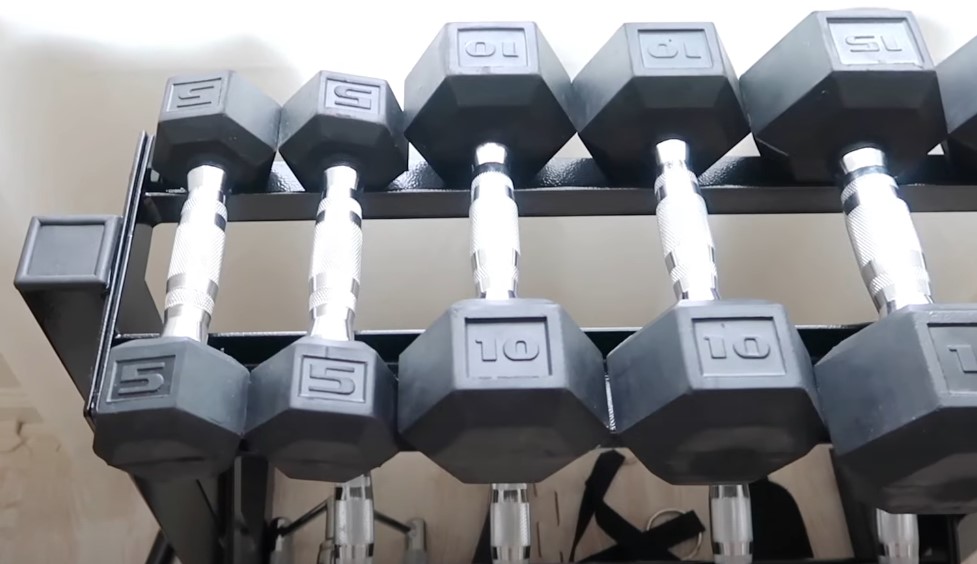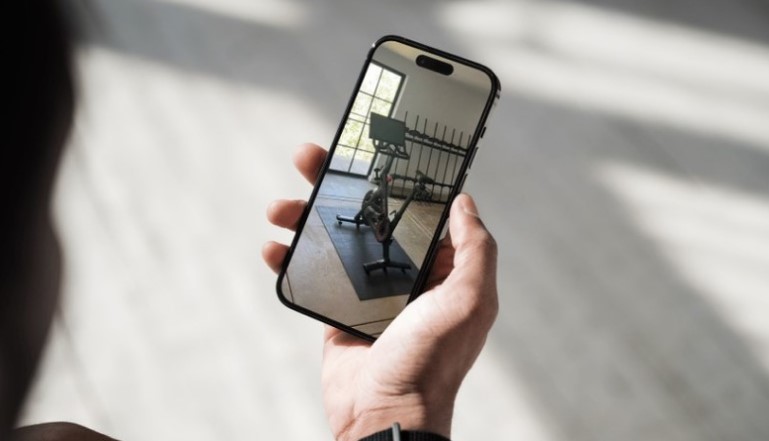Working
from
home
isn’t
all
sunshine
and
rainbows.
For
many
of
us,
it
comes
with
neck
and
back
pain,
stiff
joints,
weight
gain,
and
other
health
issues
associated
with
prolonged
sitting.
While
regular
gym
workouts
can
help,
there’s
an
even
better
option:
build
a
home
gym
so
you
can
train
anytime—even
when
your
schedule
is
jam-packed.
A
home
gym
can
cost
as
little
as
much
as
you
want
it
to.
If
you’re
on
a
budget,
start
with
adjustable
dumbbells,
resistance
bands,
and
other
training
essentials.
Weight
benches,
spinning
bikes,
and
squat
racks
come
with
a
higher
price
tag,
but
you
can
buy
them
used.
Make
a
list
of
must-haves
and
then
contact
an
interior
designer
to
help
you
maximize
your
space.
For
example,
they
could
help
you
turn
any
room
into
a
home
gym
that
blends
seamlessly
with
your
decor.
Their
online
portfolios
are
often
based
on
interior
design
website
templates,
but
when
it
comes
to
working
with
clients,
everything
is
done
from
scratch.
First,
research
your
options
in
terms
of
training
equipment.
Consider
your
budget,
workout
preferences,
and
how
much
space
you
have
available.
Here’s
how
to
get
started.
Set
Up
a
Budget-Friendly
Gym
You’ll
Want
to
Spend
Time
In

YouTube/Screenshot,
Take
small
steps
and
you’ll
end
up
with
perfect
gym
in
a
couple
of
months
Building
a
home
gym
costs
anywhere
between
$300
and
$15,000
or
more,
with
the
average
being
around
$2,000.
What
you’ll
pay
depends
on
its
size,
layout,
location,
equipment,
and
other
factors,
such
as
the
addition
of
mirrors
or
flooring.
However,
you
don’t
have
to
do
it
all
at
once.
Instead,
cover
the
basics
and
add
more
stuff
over
time.
Use
the
strategies
below
to
plan
things
out.
Define
Your
Must-Haves
Start
by
making
a
list
of
exercise
machines
and
accessories
for
your
home
gym,
organized
into
three
categories:
-
Must-haves:
These
may
include
dumbbells,
kettlebells,
elastic
bands,
weight
plates,
and
other
accessories
you
absolutely
need
or
want. -
Nice-to-haves:
These
are
items
you
plan
to
buy
sooner
or
later.
For
example,
a
barbell,
squat
rack,
or
treadmill.
Take
them
into
account
when
designing
your
workout
space. -
Dream
equipment:
These
are
larger
or
more
expensive
items
you’d
like
to
have
but
can
live
without,
such
as
a
rowing
machine
and
battle
ropes.
Next,
look
up
the
products
on
your
must-have
list.
Compare
their
features,
check
the
current
prices,
and
determine
which
items
are
worth
buying
brand
new.
For
instance,
a
used
set
of
dumbbells
or
kettlebells
will
be
just
as
good
as
a
brand-new
one.
Resistance
bands,
on
the
other
hand,
wear
out
pretty
fast,
so
it’s
best
to
buy
them
new
unless
you
find
some
barely
used
ones.
Prioritize
Multifunctional
Pieces

YouTube/Screenshot,
Suspension
trainers
are
a
must,
as
they
are
cheap
and
very
effective
Some
pieces
of
equipment
can
be
used
for
multiple
exercises
and
can
replace
dozens
of
gym
machines,
but
they’ll
require
often
maintenance.
Think
of
suspension
training
systems,
adjustable
dumbbells,
exercise
balls,
or
pull-up
bars.
For
example,
a
suspension
trainer
like
TRX
takes
very
little
space
and
allows
for
both
cardio
and
strength
workouts.
It’s
ideal
for
rows,
lunges,
pull-ups,
mountain
climbers,
biceps
curls,
triceps
kickbacks,
and
all
sorts
of
squats.
Suspension
training
can
be
just
as
effective
as
traditional
gym
workouts.
In
one
study,
men
who
used
a
suspension
trainer
three
times
per
week
for
two
months
experienced
significant
improvements
in
muscle
strength,
speed,
and
overall
physical
performance.
Their
risk
of
lower
extremity
injuries
decreased,
too.
Skip
the
Frills
Trust
us,
you
don’t
need
designer
gym
flooring,
mood
lighting,
or
smart
home
gym
equipment
to
get
your
heart
pumping.
The
same
goes
for
calf-raise
machines,
upright
benches,
ab
boards,
and
similar
products.
Let’s
assume
you
want
to
build
core
strength.
Believe
it
or
not,
the
best
core
exercises
require
little
or
no
equipment
and
are
more
effective
than
any
gym
machine.
Think
planks,
crunches,
Russian
twists,
side
bends,
TRX
rows,
or
Turkish
get-ups.
Consider
Your
Workout
Style

YouTube/Screenshot,
With
dumbells
you
can
work
more
than
just
a
strength
training
Do
you
prefer
cardio
exercises,
strength
training,
or
functional
workouts?
Is
there
a
running
trail
or
park
in
your
area?
Would
you
rather
lift
weights
or
use
resistance
bands?
Consider
these
aspects
when
planning
your
home
gym.
If,
say,
you
live
close
to
a
park,
you
may
not
need
an
indoor
bike
or
other
cardio
machines.
Jogging
or
outdoor
cycling
should
be
enough
as
far
as
cardiovascular
exercise
goes.
Think
about
your
health,
too.
For
example,
if
you
have
lower
back
pain,
you
may
be
better
off
using
dumbbells
or
resistance
bands
than
a
barbell.
Get
a
Good
Deal
on
Used
Equipment

can
find
a
lot
of
cheap
equipment
online
Facebook
Marketplace
and
other
online
platforms
can
be
a
goldmine
for
exercise
enthusiasts.
With
some
luck,
you
could
get
like-new
equipment
for
next
to
nothing.
Depending
on
where
you
live,
check
out
these
platforms
to
grab
a
good
deal:
- Craigslist
- eBay
- OfferUp
-
Classified
ads -
Play
It
Again
Sports -
Online
forums
and
communities
(e.g.,
local
Facebook
groups)
Look
for
simple,
durable
items
like
kettlebells,
weight
plates,
and
plyo
boxes.
Used
rowing
machines
and
indoor
bikes
can
be
a
steal,
too,
since
many
people
sell
them
due
to
lack
of
use
or
space
constraints.
If
possible,
see
the
items
in
person
before
you
buy.
Alternatively,
ask
the
seller
to
record
a
video—especially
when
it
comes
to
electronic
cardio
machines
or
more
complex
pieces
of
equipment,
such
as
spinning
bikes.
Last
but
not
least,
don’t
force
yourself
into
buying
stuff
you
don’t
want
or
need.
For
instance,
many
athletes
praise
the
Assault
AirRunner
or
the
Concept
2
RowErg.
These
machines
are
great
and
can
last
for
years,
but
are
you
going
to
use
them
often
enough
to
justify
the
cost?
If
yes,
then
go
for
it.
But
if
you’re
more
comfortable
using
a
standard
indoor
bike
or
jogging
outdoors,
then
keep
your
money.
Remember,
you
can
always
“upgrade”
later
on.
Bottom
Line
Building
a
home
gym
doesn’t
have
to
break
the
bank
or
overwhelm
your
living
space.
Start
with
the
essentials
that
match
your
fitness
goals,
and
gradually
expand
as
your
needs
evolve
and
your
budget
allows.
Prioritize
multifunctional
and
space-saving
equipment
to
maximize
your
investment,
and
don’t
be
afraid
to
buy
secondhand
from
reputable
sources.
Remember,
your
home
gym
should
be
practical,
comfortable,
and
suited
to
your
workout
style—not
just
trendy
or
overly
expensive.
Whether
you’re
lifting
weights,
doing
bodyweight
exercises,
or
focusing
on
cardio,
consistency
and
dedication
matter
more
than
having
the
fanciest
gear.